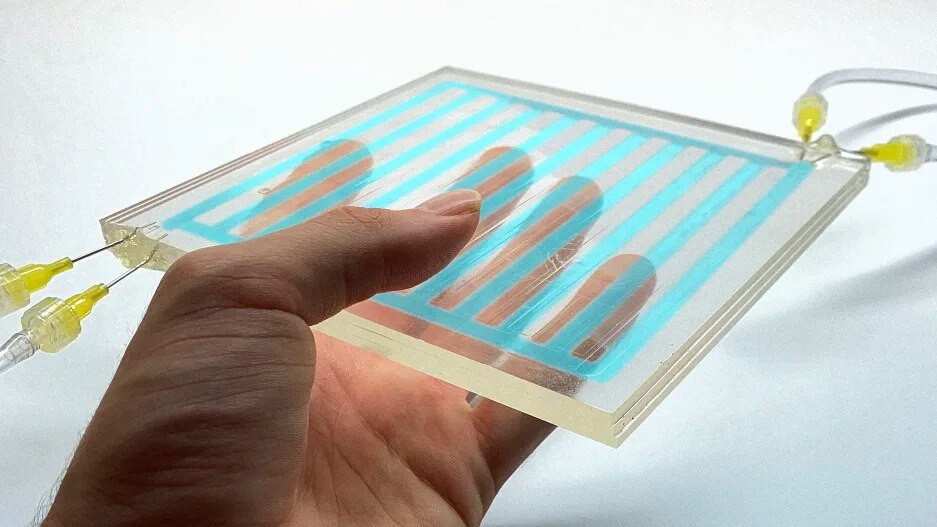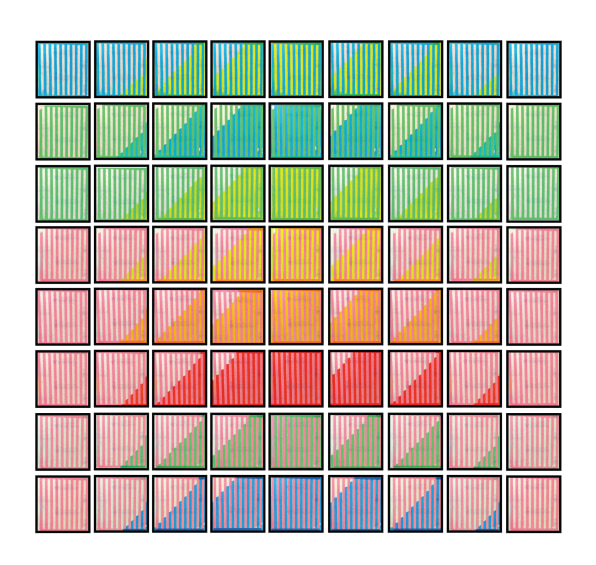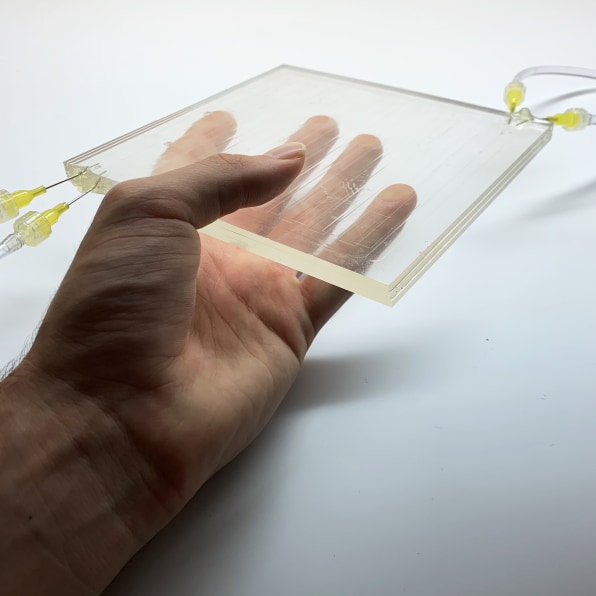- | 9:00 am
‘Liquid windows’ could be the answer to more sustainable buildings
Researchers from the University of Toronto built a prototype window that lets you control the intensity, color, and dispersion of sunlight using nothing but water and a pumping system.

Windows on their own are helpless. If you want to reduce how much light, or heat, comes into your home office on a clammy summer day, you have no choice but to call in reinforcements like shutters, shades, blinds, drapes, or even worse—air-conditioning.
This happens because typical windows are made up of an air gap sandwiched between two solid panes of glass, and both materials—if we can even call air a material—are rigid. But what if that air gap were filled with a paper-thin layer of water instead? All of a sudden, you’d have a malleable material that can reflect and refract light. You could color it and mix it with an array of molecules and particles that can scatter light, absorb heat, and dictate how much of either gets to pass through your window and enter your space.
That’s the premise behind “liquid windows,” as outlined in a new study by University of Toronto Engineering, and published in Proceedings of the National Academy of Sciences. The researchers have built a one-square-foot window that consists of up to three layers of channels sandwiched between two panes of glass. Each of these channels contains a fluid, like water, oil, or alcohol, with various optical properties. By pumping these fluids in and out of the channels, the system could optimize the kind of sunlight that passes through the window (think visible, or invisible, like infrared heat), how much of it passes through, and how it is distributed inside the space. “You can make a fluid do whatever you want optically,” says Raphael Kay, the lead author of the study. “You can also move [fluids] around easily.”
Based on computer simulations, the team found that the system could save 40% more energy than smart windows that use toxic semiconductors like indium tin oxide. For now, the concept is in its early stages, but the team believes the technology could be operational within the next five years.

Here’s how it works. If you want to control how much light passes through the windows, you could inject select amounts of carbon black pigment powder into water or alcohol to darken the window and act as a shading device, without rendering the window opaque. To control how much heat comes into your space—independently of how much light comes in—you could use specific pigments that absorb infrared heat and therefore keep it from permeating the room. And if you want to control where the light goes, you can inject nanoparticles of varying diameters that could scatter the light all the way to the back of your cavernous living room, saving up to 10% on lighting because you’d no longer have to illuminate the back of your room. “Because you can inject different chemistries and particles, you can achieve all three of these functions independently and dynamically,” says Kay.
To get the existing prototype to work, the researchers pumped the liquids manually, but eventually the system could be optimized to work like your Nest thermostat. “This could be made most efficient if all the windows are talking to each other and the whole building learns, based on solar conditions and seasons,” says Benjamin Hatton, a professor of materials science and engineering at University of Toronto and a coauthor of the study.

And that’s just the practical stuff. If you so desire, you could also inject various colored pigments and turn your room into a kaleidoscope. The channels wouldn’t be visible to the naked eye, and you would only “activate” each layer depending on the functionality you want. And because the windows would be filled with a liquid that has the same refractive index as the glass surrounding it, Kay says the view from the window would look perfectly clear, without any distortion.
It’s worth noting that the system, if it ever sees the light of day, wouldn’t replace your existing windows. “That would be a completely unrealistic uphill battle,” says Hatton. Instead, it would be tacked on the inside of your existing window, complete with discreet pumping infrastructure that is yet to be developed but will likely only need to hold a fistful of water for a standard windowpane.
While novel, the technology takes cues from nature. In a previous study to design a window that can change its opacity using nothing but oil and colored water, the same team drew inspiration from the way krill can change the color of their skin from transparent to opaque. Here, they looked at the way various species of squid can control the iridescence or light-reflecting properties on their multilayered skin. “The way we deal with climate control inside buildings is let whatever’s going to come in, come in, then we’ll figure it out after with a ton of energy on heating, cooling, and lighting,” says Kay. “The really exciting thing about biology is that [animals] control their thermal and optical properties right at the source.”
Soon enough, buildings could too.






































